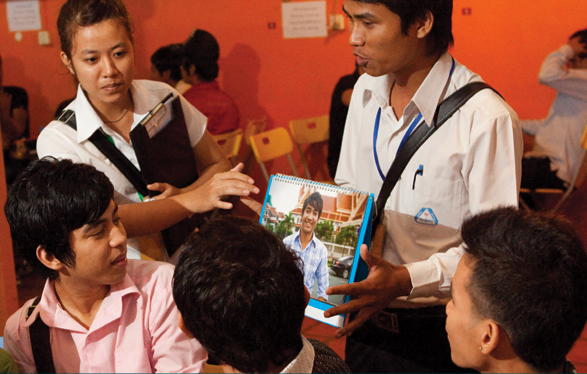I wrote the cover story for PSI Impact Magazine about how the international global health community is starting to engage deeply on youth health issues. Traditionally, the main focus has been on newborns and children, but there is a growing recognition that youth in their teens and twenties are a critical cohort to target health interventions. Have a look.
SCENE: Three women in their early 20s meet at the food court of a shopping mall. The woman who organized the gathering clearly has something on her mind. It’s her boyfriend, Rob. He doesn’t want to use a condom. “But…he takes care of me,” the young woman says sheepishly in his defense. Her friends are clearly apoplectic at the notion. They pounce. “But nothing! Aren’t you still studying?” one friend asks. “Do you really want to have a child right now?” The other friend piles on, “You know this AIDS thing is spreading to women all over.” By the end of the 30-second television commercial, the young woman is convinced. If Rob wants to be a real man, he must wear a condom.
The ad, which ran in Trinidad and Tobago, was one of 30 television spots produced by PSI/Caribbean across 11 countries in the English-speaking Caribbean. The target audience for this ad was very specific: middle-class, “uptown” young women. The message was clear: insist your man wear a condom. Other ads produced by PSI/Caribbean as part of its Got It? Get it! campaign target the kind of young man who wears his machismo on his sleeve, poorer women, sex workers and other niche demographics. The goal of promoting condom use is the same across each group.
“The Caribbean is a very sexualized culture,” observes Kerry Singh, marketing and technical director for PSI/Caribbean. “Between reggae, dance hall and soca music, the average young person is put in a sexual light at a very young age.” The data bear out. According to a 2011 UNICEF report, Latin America and the Caribbean is the region with the highest proportion of adolescent females claiming to have had their sexual debut before age 15. There is no equivalent data for men, but, according to Singh, social pressures encourage young men to have children at a young age. “Among black Caribbean male youth, there is a tendency to think that once you are 17 and you don’t have a child on the way, there must be something wrong with you,” says Singh.
The challenges that these social pressures impose on public health are stark. The younger a girl is when she becomes pregnant, the greater the risks to her health. Complications related to pregnancy and childbirth are among the leading causes of death worldwide for adolescent girls between the ages of 15 and 19. And although AIDS is not a leading cause of death among young people worldwide, one-third of all new HIV infections involve young people aged 15-24.
Young people are a relatively healthy cohort compared with other age groups. The top killers are not disease but accidents – particularly motor vehicle accidents – and violence. Still, the World Health Organization (WHO) estimates that “two-thirds of premature deaths and one third of the total disease burden in adults are associated with patterns and behaviors developed in youth.” This includes tobacco use, unprotected sex and eating patterns that can lead to obesity.
Faced with this fact, there is a growing recognition that interventions targeted at promoting healthy behaviors of youth can have a long-lasting and positive effect on public health. “Even in places where risky behaviors are culturally ingrained, young people have shown that they can make big, substantial changes that have a public health impact,” says Paul Bloem, a technical officer for adolescent health at WHO.
This view is gaining wider acceptance in the global health community. In May 2011, the World Health Assembly approved a major WHO report on youth health issues. The accompanying resolution urges member states to “develop policies and plans to address the main determinants of health affecting young people, including health-related behaviors and their impact on health at later stages in life.”
“The international community needs to pay close attention to the specific needs of global youth,” says PSI CEO Karl Hofmann. “The behaviors that young people adopt today will have a major impact on the wealth, health and well-being of their communities over the next several decades.”
Read the rest! There is also other great stuff in the issue, including interviews with the State Department Special Adviser on global youth issues Ronan Farrow; founder of the Global Health Corps Barbara Bush; and a more technically focused article on successes and failures in reaching teenage girls with health messages as they leave adolescence.
Check out the full table of contents and sign up to receive an e-copy or hard copy of the magazine for free.
